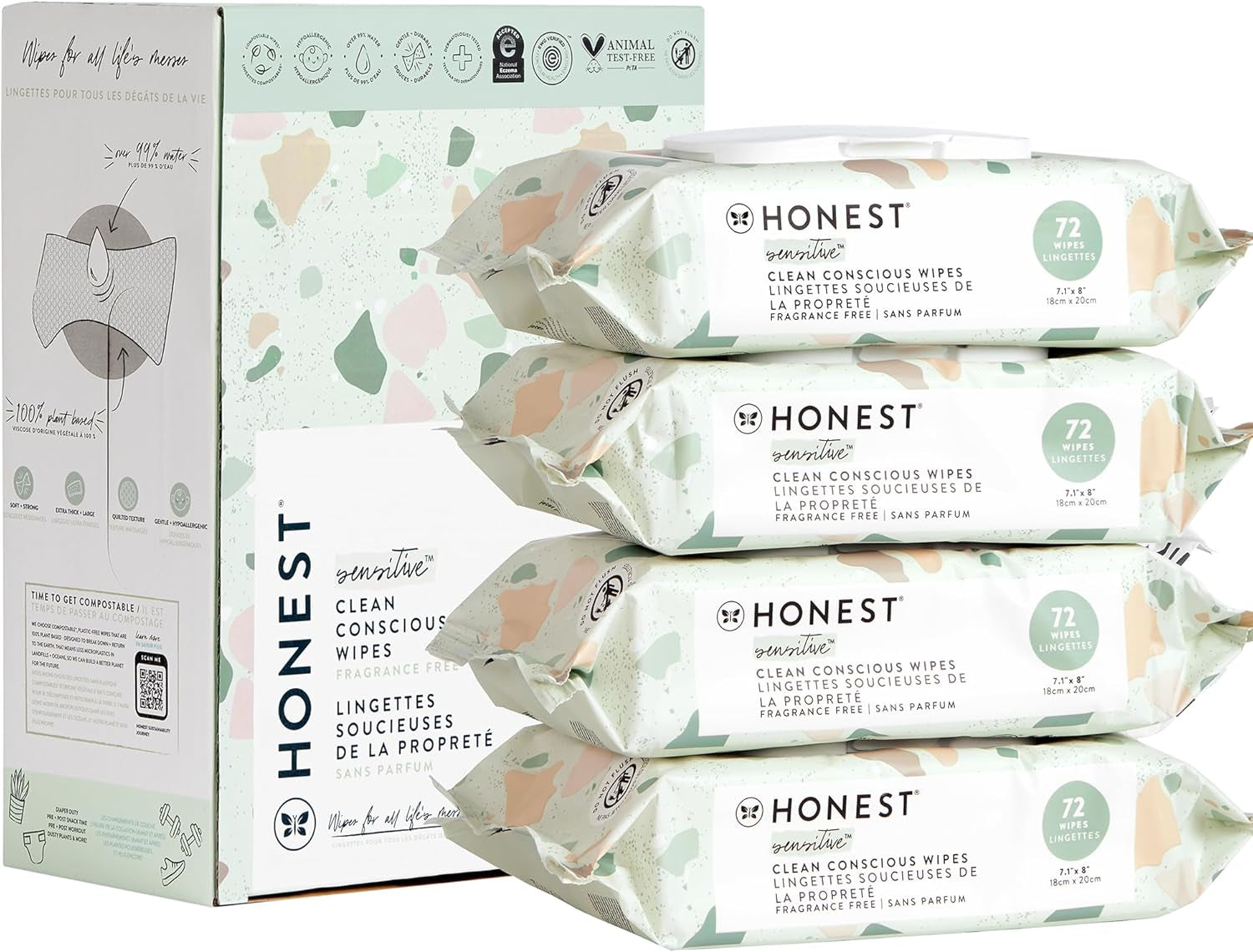

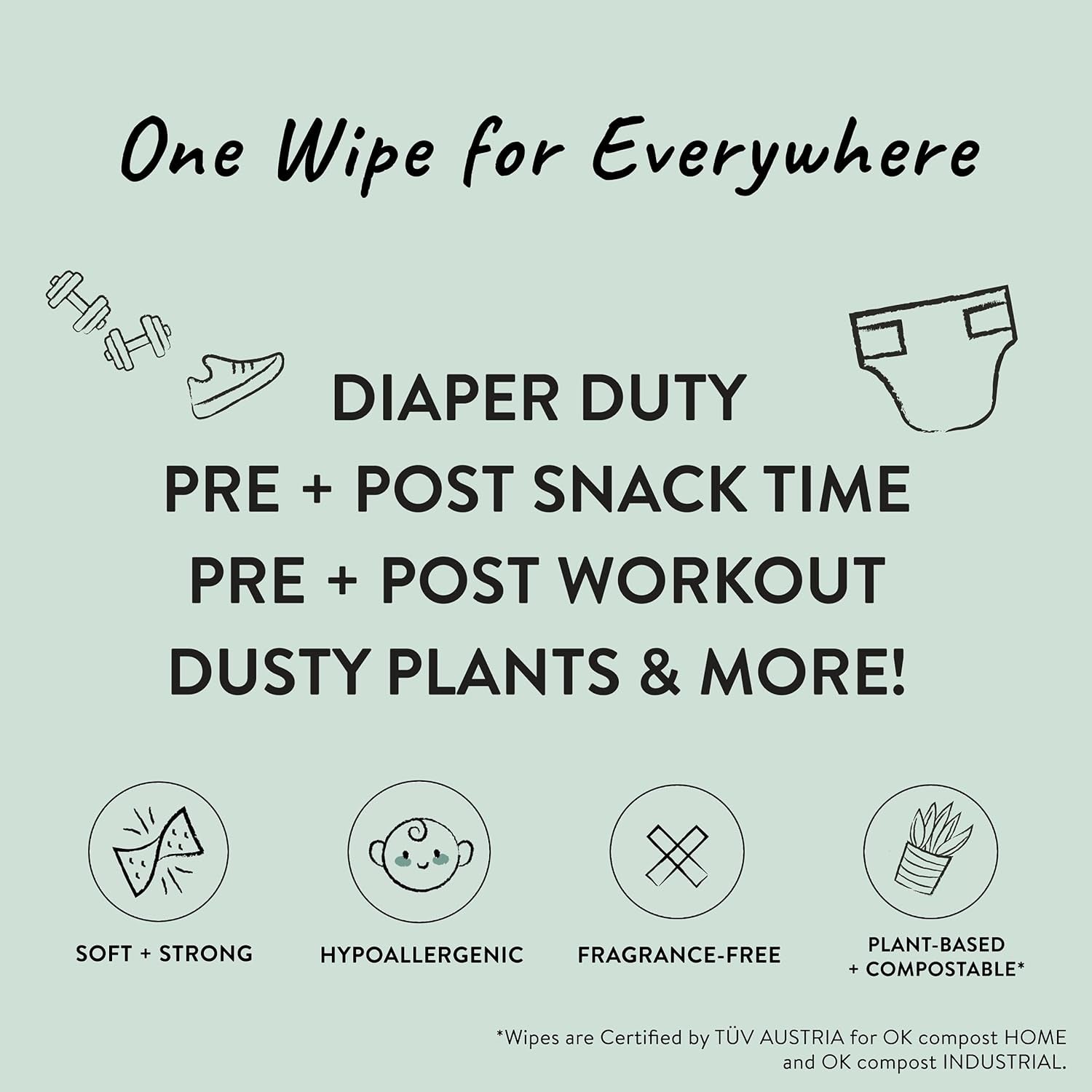

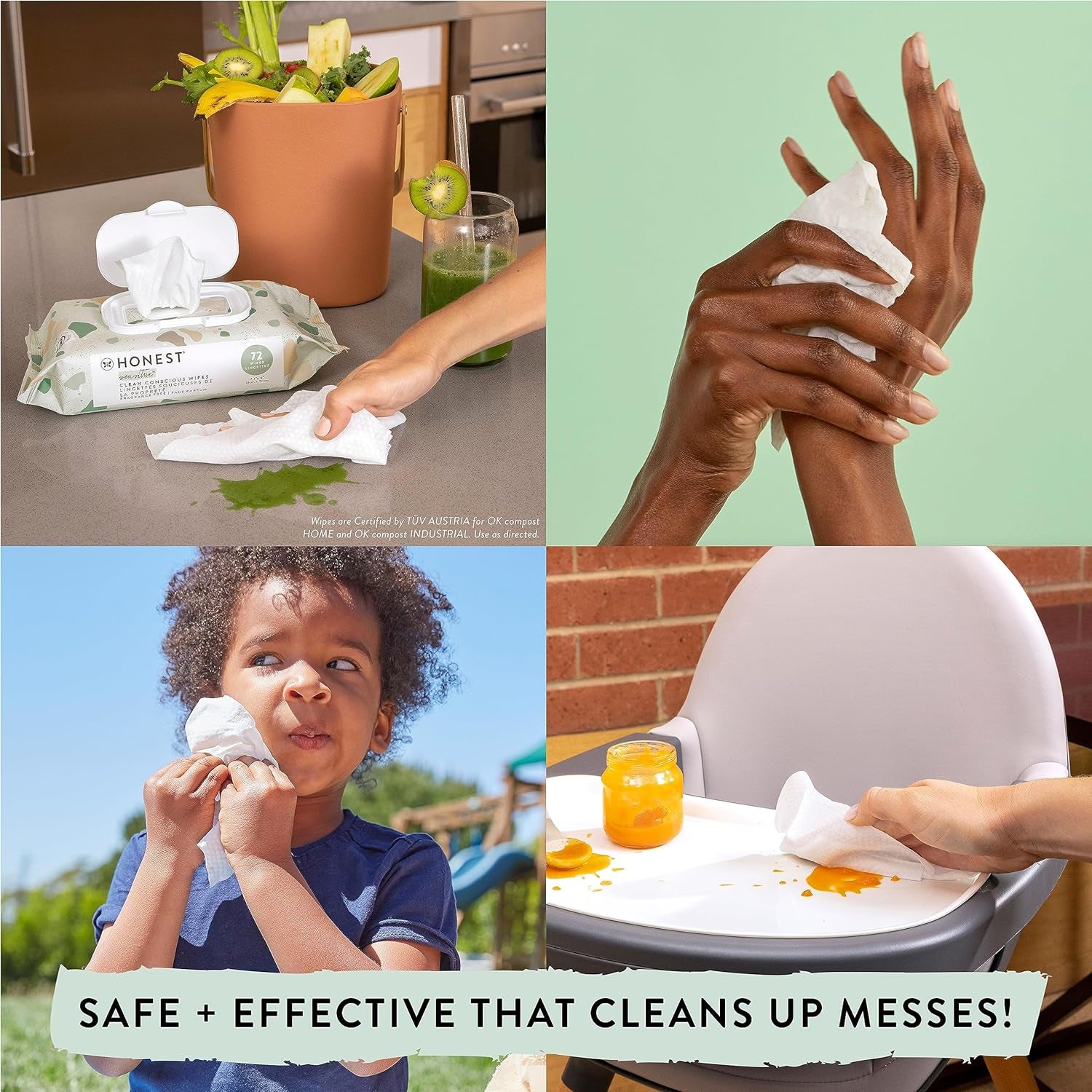

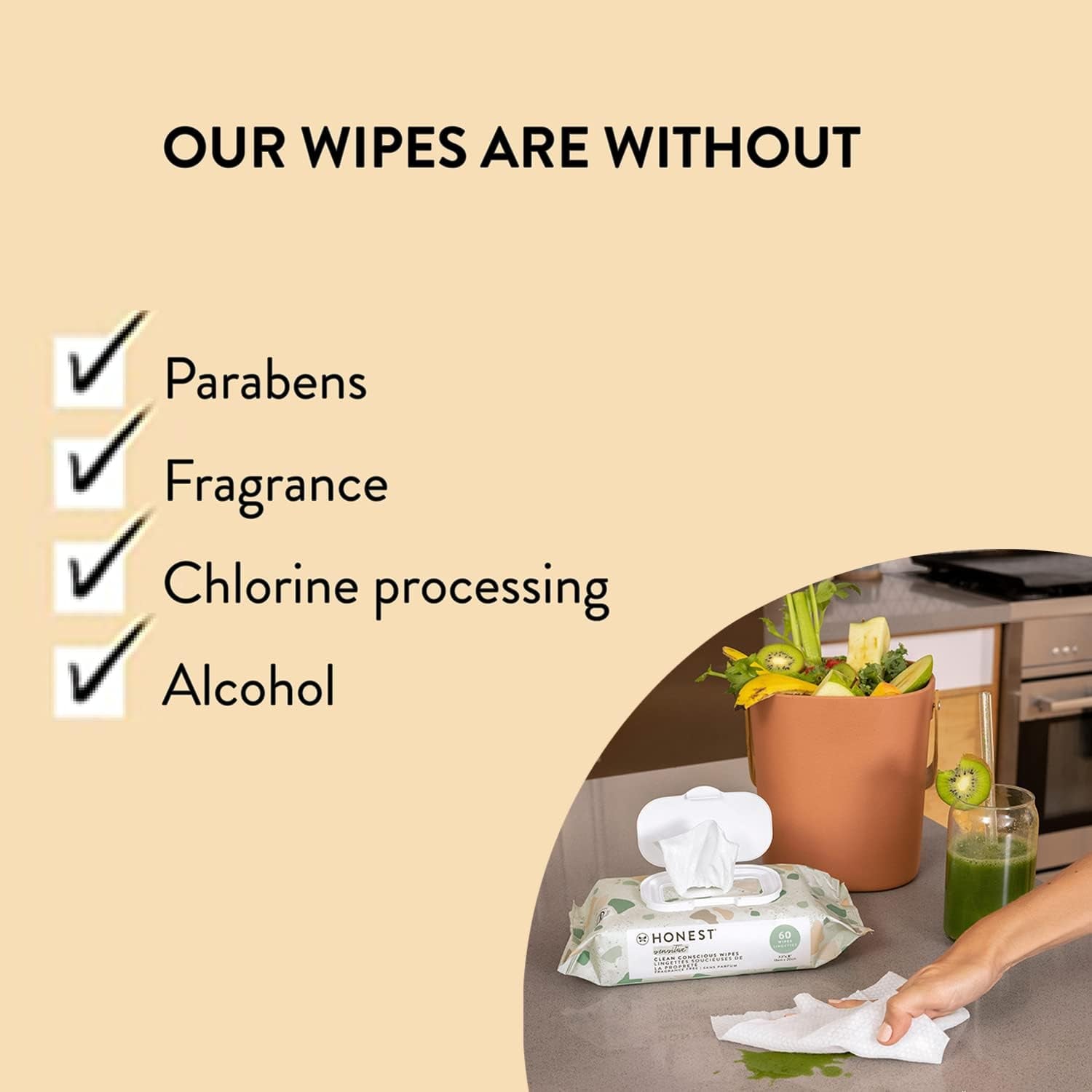
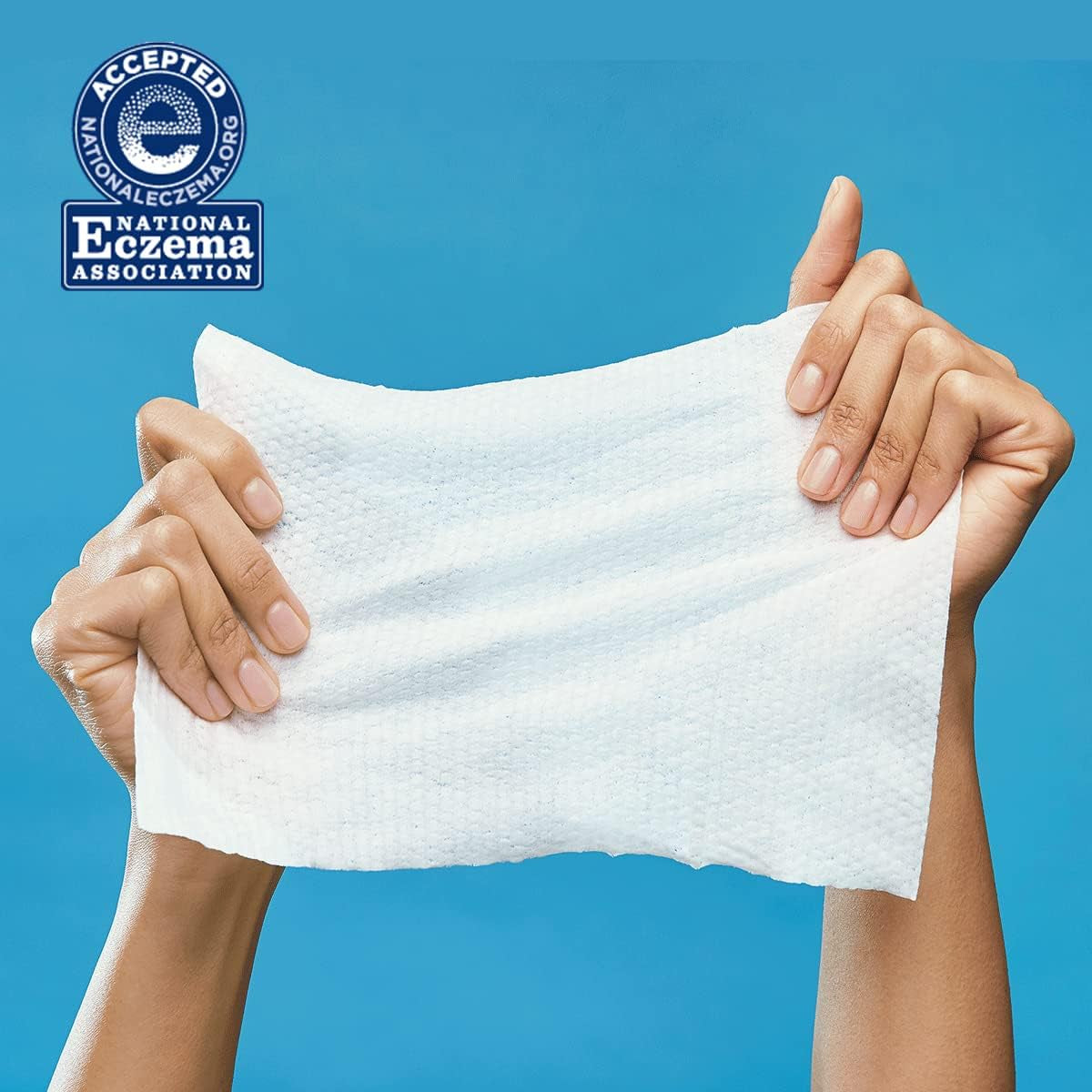

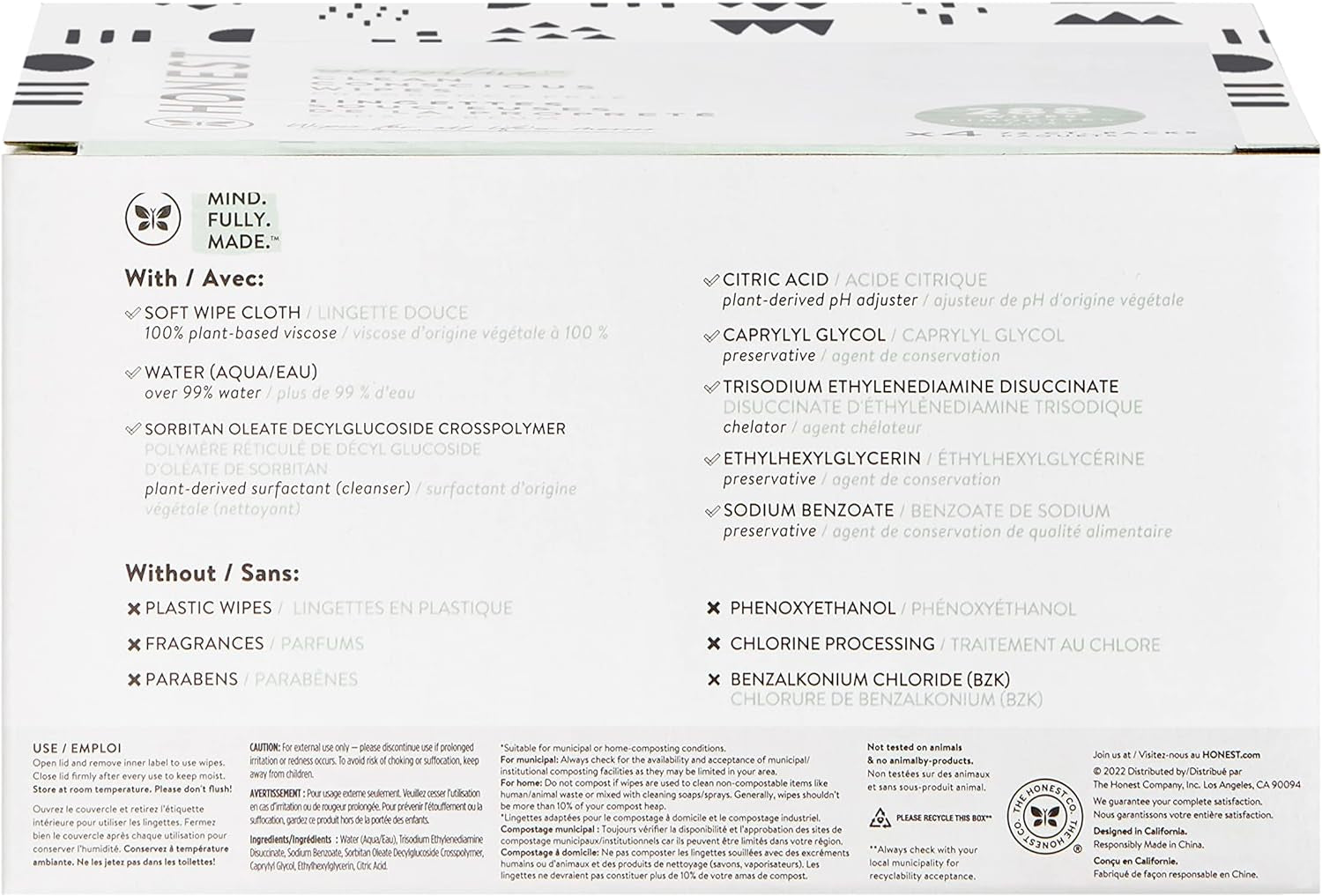
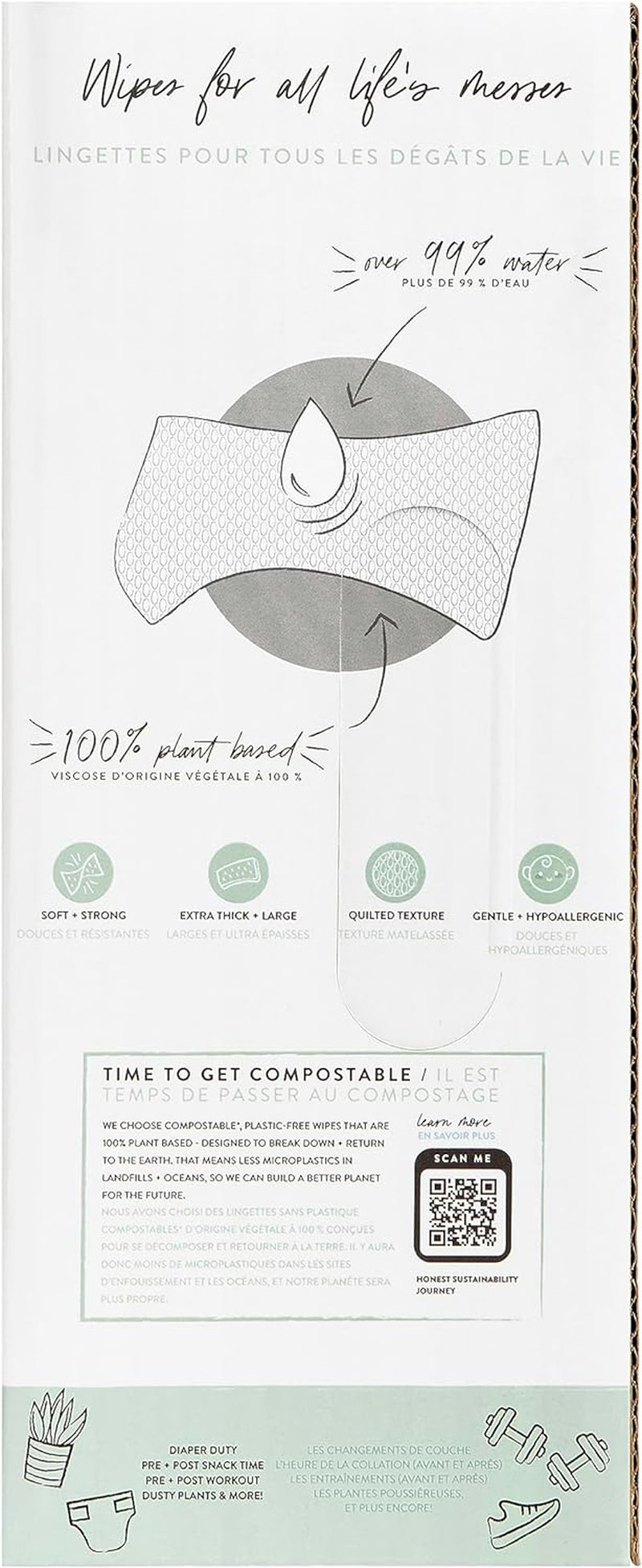
The Honest Company Wet Wipes - Hypoallergenic, EWG Verified, Compostable, 288 Count


Citric Acid
Medium RiskCitric acid is an alpha hydroxy acid used in personal care products primarily for its role as a pH adjuster and natural preservative. It occurs naturally in citrus fruits and is commonly utilized in various formulations for its chelating properties and mild exfoliation benefits.
Sustai Insights
Citric acid offers functional benefits as an effective preservative and pH stabilizer, contributing to product longevity and stability. It is biodegradable and derived from renewable sources. Health risks are low, with minimal concerns regarding carcinogenicity, allergies, and reproductive toxicity. However, moderate use restrictions exist due to potential irritation at high concentrations. Environmental risks are limited, as citric acid is not known to accumulate in ecosystems. Regulatory agencies have no significant advisories against its use. Overall, it is assessed as a medium-risk ingredient, with safe usage practices recommended and alternatives available.
Sodium Benzoate
Medium RiskSodium benzoate is a preservative commonly used in food and cosmetic products to prevent microbial growth and extend shelf life. It is derived from benzoic acid and is effective at low concentrations, often used in acidic environments like beverages and condiments.
Sustai Insights
Sodium benzoate serves effectively as a preservative, contributing to product stability and safety. It is generally recognized as safe with low concerns for carcinogenicity, allergies, and reproductive toxicity, though it faces moderate use restrictions in some regions. Environmental risks include its potential as a pollutant, but it does not bioaccumulate significantly. Regulatory bodies have issued advisories regarding its concentration in products. Overall, the risk level is assessed as medium, with safe usage practices recommended. Alternatives such as potassium sorbate may provide similar benefits with potentially lower restrictions.
Caprylyl Glycol
Low RiskCaprylyl glycol (1,2-octanediol) is a multifunctional cosmetic ingredient primarily used as a skin-conditioning agent and preservative. It is derived from caprylic acid, a fatty acid found in coconut oil, and is commonly included in personal care products for its moisturizing properties.
Sustai Insights
Caprylyl glycol offers functional benefits such as acting as an effective humectant and preservative, enhancing skin hydration and product stability. It is considered to have low health risks, with no significant concerns regarding carcinogenicity, allergies, or reproductive toxicity. Environmentally, it poses minimal risks, being non-bioaccumulative and not linked to pollution. Regulatory assessments affirm its safety, with no major advisories against its use. Overall, the ingredient is assessed to have a low risk, making it a suitable choice in cosmetic formulations.
Water
Low RiskWater is a clear, colorless liquid essential for various biological processes. It serves as a solvent in formulations, facilitating the dissolution of other ingredients and enhancing product texture and application. Additionally, water plays a crucial role in hydration and is a key component in many cosmetic and personal care products.
Sustai Insights
Water is an effective solvent and hydrator, contributing to the texture and efficacy of formulations. It is biodegradable and generally regarded as safe, with low concerns regarding carcinogenicity, allergies, and reproductive toxicity. However, excessive water usage can lead to environmental concerns, particularly regarding resource depletion. Regulatory bodies do not impose restrictions on water use in cosmetics. Overall, the risks associated with water are low, making it a safe and essential ingredient.
Ethylhexylglycerin
Low RiskEthylhexylglycerin is a glyceryl ether utilized primarily as a skin-conditioning agent and preservative in cosmetic formulations. It enhances the efficacy of preservatives and serves as a humectant, helping to retain moisture in the skin. This ingredient is commonly found in various personal care products.
Sustai Insights
Ethylhexylglycerin offers functional benefits as an effective preservative and skin-conditioning agent, contributing to product longevity and moisture retention. Health risks are generally low, with minor concerns regarding allergic contact dermatitis and irritant potential. Environmentally, it poses minimal risks, not being recognized as a pollutant or bioaccumulative. Regulatory bodies have imposed few restrictions, indicating its safety for use. Overall, its risk level is assessed as low, making it a viable option in cosmetic formulations. For those seeking alternatives, ingredients like propanediol may serve similar functions with potentially lower irritation profiles.
Trisodium Ethylenediamine Disuccinate
Low RiskTrisodium ethylenediamine disuccinate is a chelating agent commonly used in various formulations to enhance product stability and effectiveness. It functions by binding metal ions, which can otherwise catalyze degradation reactions, thereby improving the longevity and performance of personal care and cleaning products.
Sustai Insights
Trisodium ethylenediamine disuccinate offers functional benefits as an effective chelating agent that helps stabilize formulations. Its health risks are low, with minimal concerns surrounding carcinogenicity, allergies, or reproductive toxicity. Environmentally, it poses low risk, not contributing significantly to pollution or bioaccumulation. Currently, it is not restricted by regulatory bodies. Overall, the ingredient is assessed as low risk, making it a safe choice for various applications.
Sorbitan Oleate Decylglucoside Crosspolymer
Low RiskSorbitan oleate decylglucoside crosspolymer is a synthetic polymer derived from sorbitan oleate and decylglucoside. It functions primarily as an emulsifier and thickening agent in cosmetic and personal care products, aiding in the stabilization of formulations and improving texture.
Sustai Insights
Sorbitan oleate decylglucoside crosspolymer offers functional benefits as an effective emulsifier and stabilizer, enhancing product consistency. It has low health risk concerns related to carcinogenicity, allergenic potential, and reproductive toxicity. Environmentally, it presents low bioaccumulation and pollution risks. Regulatory bodies do not impose restrictions on its use. Overall, its risk level is assessed as low, making it a suitable ingredient in formulations.
Sustai Verified ensures products meet the highest standards for health, sustainability, and transparency. Each product undergoes thorough evaluation by experts who verify sustainability claims, health impacts, and ingredient integrity. Look for the Sustai Verified badge as a mark of trust and alignment with your values. Learn more on our How It Works page.
See How It Works
Sustai Verified ensures products meet the highest standards for health, sustainability, and transparency. Each product undergoes thorough evaluation by experts who verify sustainability claims, health impacts, and ingredient integrity. Look for the Sustai Verified badge as a mark of trust and alignment with your values. Learn more on our How It Works page.
See How It Works
Sustai Verified ensures products meet the highest standards for health, sustainability, and transparency. Each product undergoes thorough evaluation by experts who verify sustainability claims, health impacts, and ingredient integrity. Look for the Sustai Verified badge as a mark of trust and alignment with your values. Learn more on our How It Works page.
See How It Works
Citric Acid
Medium RiskCitric acid is an alpha hydroxy acid used in personal care products primarily for its role as a pH adjuster and natural preservative. It occurs naturally in citrus fruits and is commonly utilized in various formulations for its chelating properties and mild exfoliation benefits.
Sustai Insights
Citric acid offers functional benefits as an effective preservative and pH stabilizer, contributing to product longevity and stability. It is biodegradable and derived from renewable sources. Health risks are low, with minimal concerns regarding carcinogenicity, allergies, and reproductive toxicity. However, moderate use restrictions exist due to potential irritation at high concentrations. Environmental risks are limited, as citric acid is not known to accumulate in ecosystems. Regulatory agencies have no significant advisories against its use. Overall, it is assessed as a medium-risk ingredient, with safe usage practices recommended and alternatives available.
Caprylyl Glycol
Low RiskCaprylyl glycol (1,2-octanediol) is a multifunctional cosmetic ingredient primarily used as a skin-conditioning agent and preservative. It is derived from caprylic acid, a fatty acid found in coconut oil, and is commonly included in personal care products for its moisturizing properties.
Sustai Insights
Caprylyl glycol offers functional benefits such as acting as an effective humectant and preservative, enhancing skin hydration and product stability. It is considered to have low health risks, with no significant concerns regarding carcinogenicity, allergies, or reproductive toxicity. Environmentally, it poses minimal risks, being non-bioaccumulative and not linked to pollution. Regulatory assessments affirm its safety, with no major advisories against its use. Overall, the ingredient is assessed to have a low risk, making it a suitable choice in cosmetic formulations.
Water
Low RiskWater is a clear, colorless liquid essential for various biological processes. It serves as a solvent in formulations, facilitating the dissolution of other ingredients and enhancing product texture and application. Additionally, water plays a crucial role in hydration and is a key component in many cosmetic and personal care products.
Sustai Insights
Water is an effective solvent and hydrator, contributing to the texture and efficacy of formulations. It is biodegradable and generally regarded as safe, with low concerns regarding carcinogenicity, allergies, and reproductive toxicity. However, excessive water usage can lead to environmental concerns, particularly regarding resource depletion. Regulatory bodies do not impose restrictions on water use in cosmetics. Overall, the risks associated with water are low, making it a safe and essential ingredient.
Sodium Benzoate
Medium RiskSodium benzoate is a preservative commonly used in food and cosmetic products to prevent microbial growth and extend shelf life. It is derived from benzoic acid and is effective at low concentrations, often used in acidic environments like beverages and condiments.
Sustai Insights
Sodium benzoate serves effectively as a preservative, contributing to product stability and safety. It is generally recognized as safe with low concerns for carcinogenicity, allergies, and reproductive toxicity, though it faces moderate use restrictions in some regions. Environmental risks include its potential as a pollutant, but it does not bioaccumulate significantly. Regulatory bodies have issued advisories regarding its concentration in products. Overall, the risk level is assessed as medium, with safe usage practices recommended. Alternatives such as potassium sorbate may provide similar benefits with potentially lower restrictions.
Ethylhexylglycerin
Low RiskEthylhexylglycerin is a glyceryl ether utilized primarily as a skin-conditioning agent and preservative in cosmetic formulations. It enhances the efficacy of preservatives and serves as a humectant, helping to retain moisture in the skin. This ingredient is commonly found in various personal care products.
Sustai Insights
Ethylhexylglycerin offers functional benefits as an effective preservative and skin-conditioning agent, contributing to product longevity and moisture retention. Health risks are generally low, with minor concerns regarding allergic contact dermatitis and irritant potential. Environmentally, it poses minimal risks, not being recognized as a pollutant or bioaccumulative. Regulatory bodies have imposed few restrictions, indicating its safety for use. Overall, its risk level is assessed as low, making it a viable option in cosmetic formulations. For those seeking alternatives, ingredients like propanediol may serve similar functions with potentially lower irritation profiles.
Trisodium Ethylenediamine Disuccinate
Low RiskTrisodium ethylenediamine disuccinate is a chelating agent commonly used in various formulations to enhance product stability and effectiveness. It functions by binding metal ions, which can otherwise catalyze degradation reactions, thereby improving the longevity and performance of personal care and cleaning products.
Sustai Insights
Trisodium ethylenediamine disuccinate offers functional benefits as an effective chelating agent that helps stabilize formulations. Its health risks are low, with minimal concerns surrounding carcinogenicity, allergies, or reproductive toxicity. Environmentally, it poses low risk, not contributing significantly to pollution or bioaccumulation. Currently, it is not restricted by regulatory bodies. Overall, the ingredient is assessed as low risk, making it a safe choice for various applications.
Sorbitan Oleate Decylglucoside Crosspolymer
Low RiskSorbitan oleate decylglucoside crosspolymer is a synthetic polymer derived from sorbitan oleate and decylglucoside. It functions primarily as an emulsifier and thickening agent in cosmetic and personal care products, aiding in the stabilization of formulations and improving texture.
Sustai Insights
Sorbitan oleate decylglucoside crosspolymer offers functional benefits as an effective emulsifier and stabilizer, enhancing product consistency. It has low health risk concerns related to carcinogenicity, allergenic potential, and reproductive toxicity. Environmentally, it presents low bioaccumulation and pollution risks. Regulatory bodies do not impose restrictions on its use. Overall, its risk level is assessed as low, making it a suitable ingredient in formulations.
Discover The Honest Company Clean Conscious Unscented Wipes, designed for every family member's needs. With over 99% water and 7 simple ingredients, these wipes are perfect for sensitive skin while ensuring eco-friendliness.
- Gentle & Safe: Hypoallergenic and dermatologist-tested, these wipes are ideal for babies and sensitive skin, earning the National Eczema Seal of Acceptance.
- Versatile Use: Beyond diaper changes, they are thick and durable, perfect for cleaning toys, pets, and even for a post-workout refresh.
- Eco-Conscious: Made from compostable materials, these wipes break down in just 8 weeks, supporting a sustainable lifestyle.
- Family-Friendly: Free from harmful chemicals like fragrances and parabens, making them a safe choice for the whole family.
- Convenient Packaging: The flip-top dispenser ensures easy access and keeps wipes moist for every use.
Choose The Honest Company Wipes for a clean, safe, and environmentally responsible option.
Subscribe & Save with Sustai
- Best Price Guarantee: Always enjoy the lowest prices on sustainable home essentials.
- No Surprises: We’ll notify you before shipping. No hidden fees, ever.
- You’re in Charge: Change, pause, or cancel your subscription anytime with ease.
- Eco-Friendly Deliveries: Our grouped shipments mean less packaging and lower emissions.
Join us on a sustainable journey. Special offers for a limited time! Prices and promotions may change.
Discover The Honest Company Clean Conscious Unscented Wipes, designed for every family member's needs. With over 99% water and 7 simple ingredients, these wipes are perfect for sensitive skin while ensuring eco-friendliness.
- Gentle & Safe: Hypoallergenic and dermatologist-tested, these wipes are ideal for babies and sensitive skin, earning the National Eczema Seal of Acceptance.
- Versatile Use: Beyond diaper changes, they are thick and durable, perfect for cleaning toys, pets, and even for a post-workout refresh.
- Eco-Conscious: Made from compostable materials, these wipes break down in just 8 weeks, supporting a sustainable lifestyle.
- Family-Friendly: Free from harmful chemicals like fragrances and parabens, making them a safe choice for the whole family.
- Convenient Packaging: The flip-top dispenser ensures easy access and keeps wipes moist for every use.
Choose The Honest Company Wipes for a clean, safe, and environmentally responsible option.

You can have at most 2 Sustainable Steals products in your cart
Customer Reviews
Customers’ View
Customers appreciate the quality and gentle nature of the Clean Conscious Unscented Wipes, noting their effectiveness for both diaper changes and general cleaning tasks. Many highlight the wipes' substantial thickness and durability, which allows them to handle tough messes without tearing. Users also commend the wipes for being soft and hypoallergenic, making them safe for sensitive skin. The absence of fragrances and harmful chemicals is particularly valued by parents seeking safe options for their children. While opinions on value for money vary, many agree that the wipes are worth the investment due to their eco-friendly, compostable materials. Overall, customers find these wipes to align well with their health-conscious and environmentally friendly lifestyles.
AI-generated from the text of customer reviewsThis product has no reviews yet.


